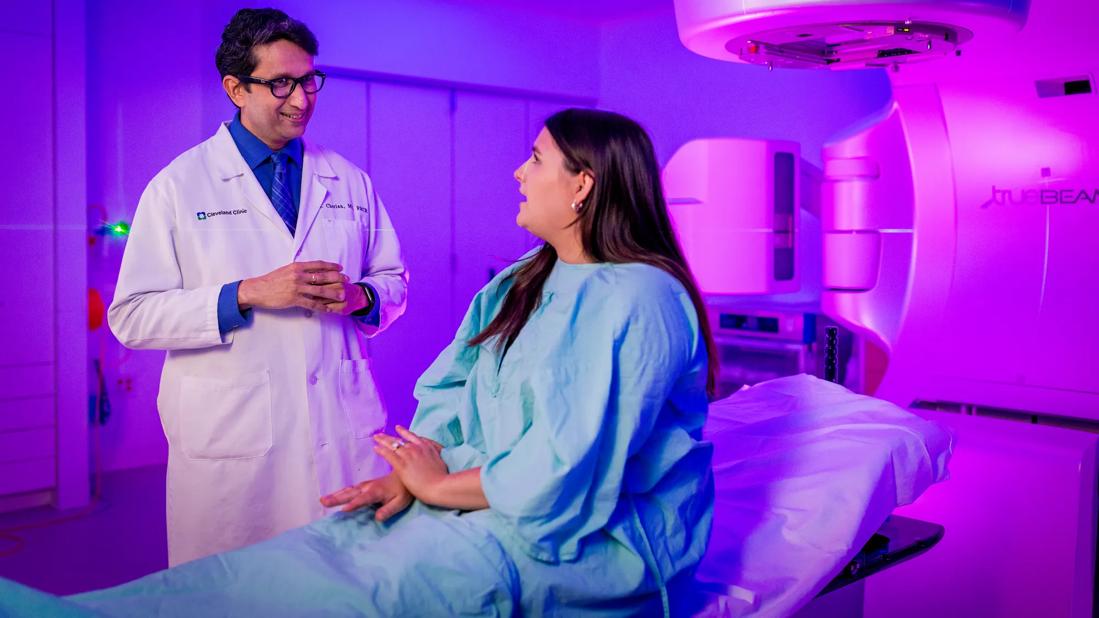Ultra-Hypofractionated Whole Breast Irradiation and Partial Breast Irradiation Reduce Many Toxicities

In an era where clinicians are increasingly recognizing the value of de-intensifying treatment where appropriate, radiation therapy (RT) is evolving. While RT remains a mainstay of breast cancer, the methods of radiation delivery have improved, as outlined in a review written by a team of oncologists at Cleveland Clinic Cancer Institute.
Advertisement
Cleveland Clinic is a non-profit academic medical center. Advertising on our site helps support our mission. We do not endorse non-Cleveland Clinic products or services. Policy
Breast cancer screening tools have been fine-tuned over the past few decades, resulting in the majority of patients being diagnosed with early-stage disease. This has led the radiation community toward approaches such as ultra-hypofractionated whole breast irradiation and partial breast irradiation.
Unlike years ago when virtually all patients were prescribed a five-to-six-week course of RT, today selected patients with low-risk disease may have a shorter course of therapy. In some cases, RT can be delivered in much fewer sessions.
• Ultra-hypofractionated WBI (Five-day course). Studies such as the Fast Forward trial showed that ultra-hypofractionated WBI is safe and equally effective at local control for early breast cancer. With this approach, the risk of toxicities such as skin redness, burning, tightness and tenderness are extremely low. "The other benefit of ultra-hypofractionated radiation is economic. Active women are not asked to take more time out of their busy schedule. There is little toxicity, so they can continue to work, drive and carry on their responsibilities,” says Cleveland Clinic radiation oncologist Sheen Cherian, MD.
Currently, ultra-hypofractionated WBI is only recommended in cases where surgery resulted in clean margins and there is no metastasis. “The biologically effective dose delivered over the five-day course is quite high, so we have to ensure we have great precision as well as great protection for surrounding tissue,” says Dr. Cherian. Precise radiation machines make it possible to fine- tune the radiation and also perform live assessments of the radiation to ensure the target is accurate.
Advertisement
• PBI (5- to 15-day course). Additionally, it’s possible to shrink the target to the lumpectomy cavity in patients with early-stage disease. PBI delivered with intensity-modulated RT has been shown to improve patients’ quality of life by reducing acute and chronic toxicities.
Note: In their review of de-intensification initiatives, the clinicians cautioned that single-fraction interoperative radiation is not considered appropriate for deintensification because studies show it increases the recurrence rate.
There are potential cases for eliminating RT from the treatment regimen altogether. For example:
• Certain populations with low-risk disease. Currently, there is no type of invasive breast cancer that doesn’t benefit from RT to achieve local control. However, as breast cancers continue to be found earlier, clinicians believe there will be a cohort of patients who can avoid RT. Already, patients over 65 with a relatively small, low-grade, estrogen-positive tumor may be treated with surgery and oral medication alone.
• Therapeutic response. Emerging evidence also shows that certain patients with breast cancer may avoid RT if pre-surgical chemotherapy and surgery demonstrate a complete pathologic response.
• Molecular profiling. The DCISionRT® tumor assay identified a group of patients with pre-invasive cancers who do not benefit from RT. This study was validated by the SweDCIS randomized trial.
Clinicians are closely watching many de-intensification studies, including the development of tumor assays to identify patients with active disease who are candidates for elimination of RT.
Advertisement
“I think the next decade will be the era of tailor-made radiation therapy,” says Dr. Cherian. However, he notes that patients need to be selected very carefully. “You have to think twice before you de-intensify, particularly in a young patient, to avoid the risk of relapse. By the same token, it can be very appropriate in some cases and there are a lot of de-intensification benefits, such as preventing secondary cancer risk due to radiation exposure.”
Hypofractionated RT and PBI should only be considered in facilities with advanced equipment, including:
• High-definition multi-leaf collimators that conform to the exact shape and dimension of the tumor cavity
• Devices that allow cardiac and lung-sparing radiation therapy
• Robust image guidance to ensure you're directing the radiation beam precisely
“The ability to perform equally effective radiation over shorter time periods is primarily due to excellent radiological screening tools, excellent national breast cancer screening programs, and excellent radiation delivery,” says Dr. Cherian.
Advertisement
Advertisement

Reconsidering axillary lymph node dissection as well as depth of surgical margins

Best practices for reducing toxicities

Partnerships with local social service agencies key to program success

Findings may guide future research and personalized treatments

Real-world results reporting aims to make treatments safer and more effective

Ongoing clinical validation refine breast cancer risk substratification

Phase 3 trial found no survival differences between weekly or biweekly doxorubicin/cyclophosphamide or between weekly or biweekly paclitaxel

Findings strengthen evidence for risk-reducing procedures